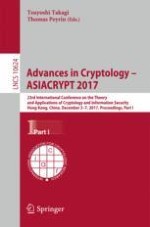2017 | OriginalPaper | Buchkapitel
Improved Conditional Cube Attacks on Keccak Keyed Modes with MILP Method
verfasst von : Zheng Li, Wenquan Bi, Xiaoyang Dong, Xiaoyun Wang
Erschienen in: Advances in Cryptology – ASIACRYPT 2017
Aktivieren Sie unsere intelligente Suche, um passende Fachinhalte oder Patente zu finden.
Wählen Sie Textabschnitte aus um mit Künstlicher Intelligenz passenden Patente zu finden. powered by
Markieren Sie Textabschnitte, um KI-gestützt weitere passende Inhalte zu finden. powered by
